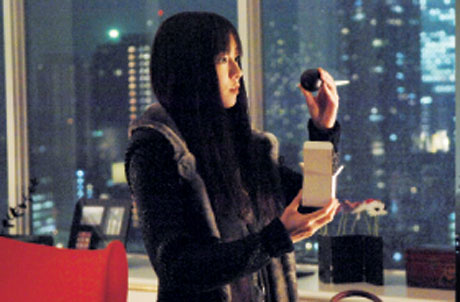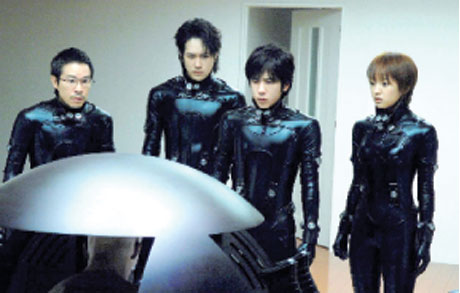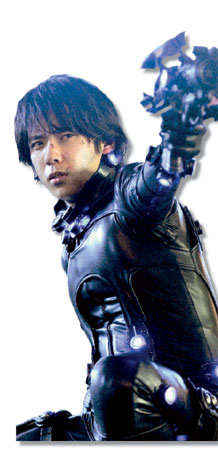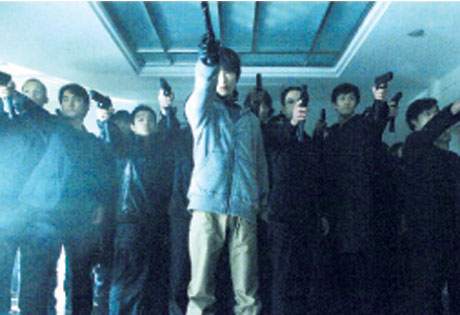Some questions are best left unanswered
Updated: 2011-05-14 06:51
By Elizabeth Kerr(HK Edition)
|
|||||||
|
Eriko (Ito Ayumi) finds another orb in her apartment that compels her to do its bidding, the second part of the manga opus Gantz: Perfect Answer. |
|
The alien assassins get their marching orders from the mysterious orb in Gantz. |
The Japanese movie industry learns to make the most of a property too. Elizabeth Kerr reports.
Though to the naked eye they may seem like the exact same thing, the film and its sequel (or four) and the two-part film are two totally different things. Back in 2003 when Quentin Tarantino insisted on releasing Kill Bill as two volumes, many wondered if he'd finally bought into his own press. Kill Bill: Vol. 1 was constructed in such a way that if you saw it and liked it, there was no way you were letting the second part slip by. If television could do cliffhangers that ensured viewers would return the following year, then so could movies.
|
Kei (Ninomiya Kazunari) dons the Matrix-y garb and set out on his mission to destroy all aliens in Gantz: Perfect Answer, the second part of the manga adaptation. |
Of course, there is the argument that desperate film studios are simply looking for new ways to stretch out a given property's box office life. The upcoming Breaking Dawn duo, based on the last book of the interminable Twilight series, and Harry Potter and the Deathly Hallows: Part 2 are both sequels as well as two-parters, the rationalization being one film would never do justice to the source material. But they are also cash cows. Together those series account for approximately $8 billion of our movie ticket dollars (and counting) in the last decade. That number is also more than the GDP of East Timor, Seychelles, and Belize combined in 2009.
At those rates it's no wonder the ailing Japanese film industry decided to get in on the two-part act. Similar to Hollywood, Japan has a long, dense, and diverse manga tradition to draw on, and it does so shamelessly. In the West, comics are the basis for CGI-heavy summertime (would-be) blockbusters and not much else. Not so in Japan. They are the foundation of countless animated series, for children and adults, television dramas, and even the occasional novel (Death Note was given a novel prequel). There's no shortage of it and the sales volume of the more popular titles would suggest a massive built-in audience for an adaption of any kind.
So Oku Hiroya's Gantz, which has already been made into an anime series, seemed like the perfect two-part property (there are almost 30 volumes in total). At the risk of sounding the blasphemer to manga-philes, Gantz isn't that original: it's a hero's quest to save the world and the girl. But subsequent to the release of 1999/2000's Battle Royale (the book then the film), the Japanese pop culture industry has run wild with its own distinct entertainment sub-genre: the death game thriller. That tends to be a youth-based actioner wherein our intrepid post-adolescent heroes and heroines are forced to fight for their lives after becoming trapped or sucked into a twisted game where the prize is their life. Most recently there was the dreadful Liar Game, and the first Gantz threw in a little Cube, a little TRON, and a little The Matrix (everything has a little Matrix in it these days) in an attempt at novelty.
The first Gantz was by no means high art, but it did undermine the form ever so subtly. Director Sato Shinsuke (The Princess Blade) turned the tables on the format when he gave his protagonists the power to escape the limbo they were pulled into, effectively negating the mercenary nature of the story. No one wanted or needed to "win". They were trying to work their collective way out - and back to life.
The saga began when withdrawn high schooler Kato (Matsuyama Kenichi, Norwegian Wood) and his old buddy Kei (Ninomiya Kazunari, Letters from Iwo Jima) got hit by an onrushing train. They woke up in a futuristic standard white room where the enigmatic orb, Gantz, turned them and the other strangers in the room into black leather-clad alien assassins. There was a pile of repetitive fighting, Kato got a few minutes back in the real world every so often, and Kei went mad with power. Then it ended on a massive cliffhanger. Gantz was too long for its introductory tone, but it did set up the second film perfectly. It was all about questions, with Kato, Kei and the rest of the motley crew struggling to figure out what was going on.
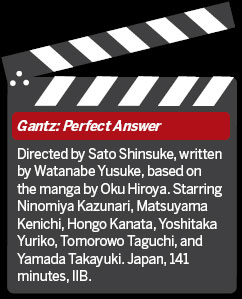
As can be inferred from the title, Gantz: Perfect Answer sets out to solve the mysteries and get to the heart of the matter. And in doing so it doesn't sit still. The exposition fairy gets busy for the first 30 minutes and almost brings the film to a screeching halt. Almost. The action-packed Perfect Answer begins with Kei trying to revive Kato, who died in the first film's final battle. He's also making goo-goo eyes at Tae (Yoshitaka Yuriko), a budding manga artist who may or may not know what's really going on with all these limbos-and who is being hunted by aliens. The aliens are being guided by Eriko, (Ito Ayumi), who is in league with the orb. Maybe. Also lurking on the periphery is Shigeta (Yamada Takayuki), a detective who seems to know something about the orb, but who may be a double agent. Oh, and there are now two Katos, one who is evil incarnate. And that is the tip of the narrative iceberg.
The single biggest issue for really connecting to Gantz: Perfect Answer is the story's inherent lack of consequences. Yes, it's a goofy, sci-fi romp with no palpable logic about it but that doesn't preclude building tension that creates a vested interest in the characters for viewers. Like Part 1, Perfect Answer hits the repeat button too many times, and the "death" of characters means very little. They just reset and wake up with the orb and carry out yet another similar mission, which more often than not ended in a Mexican standoff. The already tired death game genre received a bit of a jolt the first time around with a few twists that peaked curiosity for the conclusion, but Sato and Co. quickly fall into rote action-adventure this time around and get no help from bland performances by Yoshitaka and particularly Ninomiya. Answering too many questions in too little time make for a muddled experience the second time around. And to think Sato could have stretched Gantz to at least four movies.
Gantz: Perfect Answer opened in Hong Kong on Thursday.
|
In an effort to be as repetitive as possible, Gantz: Perfect Answer sets up yet another stylish Mexican standoff as major action piece. |
(HK Edition 05/14/2011 page4)
